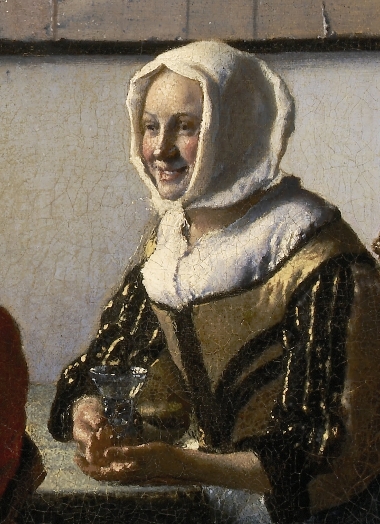Painting Whitewashed Walls
Although rarely discussed, the prosaic whitewashed walls that set the stage for the artist's quiet little dramas are crucial components of Vermeer's interiors. These walls not only mark the furthest limits of the picture's implied three-dimensional space but silently orchestrate the mood of each scene and establish the broader scheme of illumination by which the chiaroscural and chromatic relationships of the architectural features, figures, and movable objects are appropriately gauged.
Painting a simple whitewashed wall is difficult in oil painting for several reasons that involve perceptual constancies and the way we interpret visual stimuli. Perceptual constancy is our ability to see things as being constant even when the lighting, angle, or other visual conditions change. We perceive the whiteness of the wall as constant even if it receives varying amounts of light. The artist must use gradients of gray paint and shifts in value to render the wall's three-dimensionality, and particular lighting without losing the perception that it is indeed white.
When light falls on a simple whitewashed wall, the falloff—the way the light's intensity diminishes with distance—is not linear due to the Inverse Square Law. This law states that light intensity is inversely proportional to the square of the distance from the source. Near the light source, the intensity is at its highest, causing the wall to appear very bright at the point where the light strikes it directly. As one moves away from this point, the brightness diminishes much more rapidly than the distance increases. Therefore, if the distance from the light source to the wall is doubled, the illumination on the wall doesn't reduce by half; rather, it becomes a quarter as bright. The painter must account for this, adjusting the tone and hue of the paint, guided by knowledge, experience, and intuition, rather than by direct perception. The untrained painter will almost inevitably avoid what they believe is excessive contrast, resulting in a wall that appears a pallid gray, and the illusion of the falloff of light is compromised.

Johannes Vermeer
c. 1655–1660
Oil on canvas, 50.5 x 46 cm.
Frick Collection, New York
The illustration below of Vermeer's Woman with a Pearl Necklace demonstrates how strongly the rendering of a background wall influences the viewer's perception of the rest of the work. If the standing figure were cut and pasted closer—our eyes gauge the appropriateness of tone of the figure by the tone of the surrounding background wall—its lights, shadows, and half tones are dramatically upset. The new figure is dark, pancake-flat, and isolated from its environment. In order to restore the correct chiaroscural values of the figure, it would have to be entirely repainted.
In oil painting, the naturalistic rendering of a brightly lit wall, such as those found in the works of Pieter de Hooch or Vermeer, is a challenging undertaking. However, while De Hooch depicted his walls in a fairly rough and standardized manner, attentive examination shows that Vermeer experimented with a more refined and broader range of techniques just as he had done with other preferred motifs of his (e.g. leaded windows, floor tiles, wall maps etc.). Vermeer's exceptional powers of observation and pictorial synthesis allowed him capture nuances of light, shade and texture in his walls that De Hooch either ignored or was unable to represent.
In Vermeer's walls, the broader left-to right chiaroscural variation immediately establishes the direction and intensity of the incoming light and how it gradually diminishes as it flows obliquely over its surface. Nail holes, cracks, crevices and other minor surface irregularities are recorded with discreet variations in the paint's tonal values. In some works, such details are "literally" depicted with darker and lighter paint, in others by digging the stiff-bristled brush into the wet, light-toned paint exposing here and there the underlying darker ground. Sometimes paint is used metaphorically. By piling up thick paint impasto in the lighter areas of the wall, the painter evoked not only the strength of the light which illuminates its surface but the crusty texture produced by repeated coating of lime which was necessary to maintain the walls clean, fully reflective, and hygienic. Minor cast shadows were often painted with thin, semi-transparent layers of darker paint in order to suggest their insubstantial nature. The contours, tones and shapes of the shadows cast by the windows, paintings-within-the-painting, maps etc. provide more precise information about the intensity and direction of the light as well as information about the morphological characteristics of the objects which cast them.

The base hue of each wall, determined by the relative coolness or warmth of the basic gray paint used to represent them, determines not so much the quantity of the light as its quality, or rather, its temperature. In the most successful renditions, it is possible to understand what time of day the painter intended to represent. For example, the bluish shadows and clean, light tones of the wall (and wall map) in the Officer and Laughing Girl suggest cool morning light. The effect is further enhanced by a striking bluish tint of the shadows on the lady's face and of her white head covering. On the other hand, the pearl-gray of the shadows cast by the background chair and the overall mute but warm gray of the wall of the Woman with a Pearl Necklace suggest afternoon light. The subdued ochres and brownish shadows of the night side of the yellow jacket of the lady confirm this impression. In Vermeer's late works, the walls are handled with thinner layers of paint which show only faint relief and modeling. One of the principal characteristics which makes Vermeer's walls so real in comparison to those of his contemporaries is the correct matching of the temperatures of the walls and the figures.
